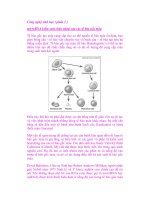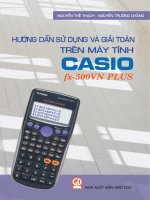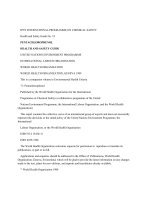Nonlinear Microwave Circuit Design phần 1 ppsx
Bạn đang xem bản rút gọn của tài liệu. Xem và tải ngay bản đầy đủ của tài liệu tại đây (607.18 KB, 40 trang )
Nonlinear Microwave
Circuit Design
F. Giannini
University of Roma, Tor Vergata, Italy
and
G. Leuzzi
University of L’Aquila, Italy
Nonlinear Microwave
Circuit Design
Nonlinear Microwave
Circuit Design
F. Giannini
University of Roma, Tor Vergata, Italy
and
G. Leuzzi
University of L’Aquila, Italy
Copyright 2004 John Wiley & Sons Ltd, The Atrium, Southern Gate, Chichester,
West Sussex PO19 8SQ, England
Telephone (+44) 1243 779777
Email (for orders and customer service enquiries):
Visit our Home Page on www.wileyeurope.com or www.wiley.com
All Rights Reserved. No part of this publication may be reproduced, stored in a retrieval system or
transmitted in any form or by any means, electronic, mechanical, photocopying, recording, scanning or
otherwise, except under the terms of the Copyright, Designs and Patents Act 1988 or under the terms of a
licence issued by the Copyright Licensing Agency Ltd, 90 Tottenham Court Road, London W1T 4LP, UK,
without the permission in writing of the Publisher. Requests to the Publisher should be addressed to the
Permissions Department, John Wiley & Sons Ltd, The Atrium, Southern Gate, Chichester, West Sussex PO19
8SQ, England, or emailed to , or faxed to (+44) 1243 770620.
This publication is designed to provide accurate and authoritative information in regard to the subject matter
covered. It is sold on the understanding that the Publisher is not engaged in rendering professional services.
If professional advice or other expert assistance is required, the services of a competent professional should
be sought.
Other Wiley Editorial Offices
John Wiley & Sons Inc., 111 River Street, Hoboken, NJ 07030, USA
Jossey-Bass, 989 Market Street, San Francisco, CA 94103-1741, USA
Wiley-VCH Verlag GmbH, Boschstr. 12, D-69469 Weinheim, Germany
John Wiley & Sons Australia Ltd, 33 Park Road, Milton, Queensland 4064, Australia
John Wiley & Sons (Asia) Pte Ltd, 2 Clementi Loop #02-01, Jin Xing Distripark, Singapore 129809
John Wiley & Sons Canada Ltd, 22 Worcester Road, Etobicoke, Ontario, Canada M9W 1L1
Wiley also publishes its books in a variety of electronic formats. Some content that appears
in print may not be available in electronic books.
Library of Congress Cataloging-in-Publication Data
Giannini, Franco, 1944-
Nonlinear microwave circuit design / Franco Giannini and Giorgio Leuzzi.
p. cm.
Includes bibliographical references and index.
ISBN 0-470-84701-8 (cloth: alk. paper)
1. Microwave circuits. 2. Electric circuits, Nonlinear. I. Leuzzi,
Giorgio. II. Title.
TK7876.G53 2004
621.381
33 – dc22
2004004941
British Library Cataloguing in Publication Data
A catalogue record for this book is available from the British Library
ISBN 0-470-84701-8
Typeset in 10/12pt Times by Laserwords Private Limited, Chennai, India
Printed and bound in Great Britain by Antony Rowe Ltd, Chippenham, Wiltshire
This book is printed on acid-free paper responsibly manufactured from sustainable forestry
in which at least two trees are planted for each one used for paper production.
Contents
Preface ix
Chapter 1 Nonlinear Analysis Methods 1
1.1 Introduction 1
1.2 Time-Domain Solution 4
1.2.1 General Formulation 4
1.2.2 Steady State Analysis 7
1.2.3 Convolution Methods 9
1.3 Solution Through Series Expansion 13
1.3.1 Volterra Series 13
1.3.2 Fourier Series 22
1.3.2.1 Basic formulation (single tone) 23
1.3.2.2 Multi-tone analysis 33
1.3.2.3 Envelope analysis 43
1.3.2.4 Additional remarks 45
1.3.2.5 Describing function 46
1.3.2.6 Spectral balance 47
1.4 The Conversion Matrix 49
1.5 Bibliography 56
Chapter 2 Nonlinear Measurements 61
2.1 Introduction 61
2.2 Load/Source Pull 62
2.3 The Vector Nonlinear Network Analyser 71
2.4 Pulsed Measurements 74
2.5 Bibliography 80
Chapter 3 Nonlinear Models 83
3.1 Introduction 83
3.2 Physical Models 84
vi CONTENTS
3.2.1 Introduction 84
3.2.2 Basic Equations 86
3.2.3 Numerical Models 88
3.2.4 Analytical Models 92
3.3 Equivalent-Circuit Models 95
3.3.1 Introduction 95
3.3.2 Linear Models 96
3.3.3 From Linear to Nonlinear 102
3.3.4 Extraction of an Equivalent Circuit from Multi-bias Small-signal
Measurements 121
3.3.5 Nonlinear Models 133
3.3.6 Packages 139
3.4 Black-Box Models 142
3.4.1 Table-based Models 142
3.4.2 Quasi-static Model Identified from Time-domain Data 143
3.4.3 Frequency-domain Models 144
3.4.4 Behavioural Models 146
3.5 Simplified Models 148
3.6 Bibliography 151
Chapter 4 Power Amplifiers 159
4.1 Introduction 159
4.2 Classes of Operation 168
4.3 Simplified Class-A Fundamental-frequency Design for High Efficiency 170
4.3.1 The Methodology 170
4.3.2 An Example of Application 180
4.4 Multi-harmonic Design for High Power and Efficiency 182
4.4.1 Introduction 182
4.4.2 Basic Assumptions 187
4.4.3 Harmonic Tuning Approach 194
4.4.4 Mathematical Statements 197
4.4.5 Design Statements 205
4.4.6 Harmonic Generation Mechanisms and Drain Current Waveforms 207
4.4.7 Sample Realisations and Measured Performances 212
4.5 Bibliography 226
Chapter 5 Oscillators 229
5.1 Introduction 229
5.2 Linear Stability and Oscillation Conditions 230
5.3 From Linear to Nonlinear: Quasi-large-signal Oscillation and Stability
Conditions 243
5.4 Design Methods 252
CONTENTS vii
5.5 Nonlinear Analysis Methods for Oscillators 259
5.5.1 The Probe Approach 260
5.5.2 Nonlinear Methods 261
5.6 Noise 269
5.7 Bibliography 276
Chapter 6 Frequency Multipliers and Dividers 279
6.1 Introduction 279
6.2 Passive Multipliers 280
6.3 Active Multipliers 282
6.3.1 Introduction 282
6.3.2 Piecewise-linear Analysis 283
6.3.3 Full-nonlinear Analysis 298
6.3.4 Other Circuit Considerations 306
6.4 Frequency Dividers – the Regenerative (Passive) Approach 308
6.5 Bibliography 311
Chapter 7 Mixers 315
7.1 Introduction 315
7.2 Mixer Configurations 318
7.2.1 Passive and Active Mixers 318
7.2.2 Symmetry 322
7.3 Mixer Design 329
7.4 Nonlinear Analysis 332
7.5 Noise 337
7.6 Bibliography 339
Chapter 8 Stability and Injection-locked Circuits 341
8.1 Introduction 341
8.2 Local Stability of Nonlinear Circuits in Large-signal Regime 341
8.3 Nonlinear Analysis, Stability and Bifurcations 349
8.3.1 Stability and Bifurcations 349
8.3.2 Nonlinear Algorithms for Stability Analysis 356
8.4 Injection Locking 359
8.5 Bibliography 368
Appendix 371
A.1 Transformation in the Fourier Domain of the Linear Differential Equation 371
A.2 Time-Frequency Transformations 372
A.3 Generalised Fourier Transformation for the Volterra Series Expansion 372
viii CONTENTS
A.4 Discrete Fourier Transform and Inverse Discrete Fourier Transform for
Periodic Signals 373
A.5 The Harmonic Balance System of Equations for the Example Circuit with
N = 3 375
A.6 The Jacobian Matrix 378
A.7 Multi-Dimensional Discrete Fourier Transform and Inverse Discrete
Fourier Transform for Quasi-periodic Signals 379
A.8 Oversampled Discrete Fourier Transform and Inverse Discrete Fourier
Transform for Quasi-Periodic Signals 380
A.9 Derivation of Simplified Transport Equations 382
A.10 Determination of the Stability of a Linear Network 382
A.11 Determination of the Locking Range of an Injection-Locked Oscillator 384
Index 387
Preface
Nonlinear microwave circuits is a field still open to investigation; however, many basic
concepts and design guidelines are already well established. Many researchers and design
engineers have contributed in the past decades to the development of a solid knowledge
that forms the basis of the current powerful capabilities of microwave engineers.
This book is composed of two main parts. In the first part, some fundamental tools
are described: nonlinear circuit analysis, nonlinear measurement, and nonlinear model-
ing techniques. In the second part, basic structure and design guidelines are described
for some basic blocks in microwave systems, that is, power amplifiers, oscillators, fre-
quency multipliers and dividers, and mixers. Stability in nonlinear operating conditions
is also addressed.
A short description of fundamental techniques is needed because of the inherent
differences between linear and nonlinear systems and because of the greater familiarity
of the microwave engineer with the linear tools and concepts. Therefore, an introduction
to some general methods and rules proves useful for a better understanding of the basic
behaviour of nonlinear circuits. The description of design guidelines, on the other hand,
covers some well-established approaches, a llowing the microwave engineer to understand
the basic methodology required to perform an effective design.
The book mainly focuses on general concepts and methods, rather than on practical
techniques and specific applications. To this aim, simple examples are given throughout
the book and simplified models and methods are used whenever possible. The expected
result is a better comprehension of basic concepts and of general approaches rather than
a fast track to immediate design capability. The readers will judge for themselves the
success of this approach.
Finally, we acknowledge the help of many colleagues. Dr. Franco Di Paolo has
provided invaluable help in generating simulation results and graphs. Prof. Tom Brazil,
Prof. Aldo Di Carlo, Prof. Angel Mediavilla, and Prof. Andrea Ferrero, Dr. Giuseppe
Ocera and Dr. Carlo Del Vecchio have contributed with relevant material. Prof. Gio-
vanni Ghione and Prof. Fabrizio Bonani have provided important comments and remarks,
x PREFACE
although responsibility for eventual inaccuracies must be ascribed only to the authors. To
all these people goes our warm gratitude.
Authors’ wives and families are also acknowledged for patiently tolerating the
extra work connected with writing a book.
Franco Giannini
Giorgio Leuzzi
1
Nonlinear Analysis Methods
1.1 INTRODUCTION
In this introduction, some well-known basic concepts are recalled, and a simple example is
introduced that will be used in the following paragraphs for the illustration of the different
nonlinear analysis methods.
Electrical and electronic circuits are described by means of voltages and currents.
The equations that fulfil the topological constraints of the network, and that form the
basis for the network analysis, are Kirchhoff’s equations. The equations describe the
constraints on voltages (mesh equations) or currents (nodal equations), expressing the
constraint that the sum of all the voltages in each mesh, or, respectively, that all the
currents entering each node, must sum up to zero. The number of equations is one half
of the total number of the unknown voltages and currents. The system can be solved
when the relation between voltage and current in each element of the network is known
(constitutive relations of the elements). In this way, for example, in the case of nodal
equations, the currents that appear in the equations are expressed as functions of the
voltages that are the actual unknowns of the problem. Let us illustrate this by means of
a simple example (Figure 1.1).
i
s
+ i
g
+ i
C
= 0 Nodal Kirchhoff’s equation (1.1)
i
s
= i
s
(t)
i
g
= g · v
i
C
= C ·
dv
dt
Constitutive relations of the elements (1.2)
where i
s
(t) is a known, generic function of time. Introducing the constitutive relations
into the nodal equation we get
C ·
dv(t)
dt
+ g · v(t) +i
s
(t) = 0 (1.3)
Since in this case all the constitutive relations (eq. (1.2)) of the elements are linear and
one of them is differential, the system (eq. (1.3)) turns out to be a linear differential
Nonlinear Microwave Circuit Design F. Giannini and G. Leuzzi
2004 John Wiley & Sons, Ltd ISBN: 0-470-84701-8
2 NONLINEAR ANALYSIS METHODS
VCg
i
c
i
g
i
s
+
−
Figure 1.1 A simple example circuit
system in the unknown v(t) (in this case a single equation in one unknown). One of
the elements (i
s
(t)) is a known quantity independent of voltage (known term), and the
equation is non-homogeneous. The solution is found by standard solution methods of
linear differential equations:
v(t) = v(t
0
) ·e
−
g
C
·(t−t
0
)
−
t
t
0
e
−
g
C
·(t−τ)
C
· i
s
(τ ) ·dτ(1.4)
More generally, the solution can be written in the time domain as a convolution integral:
v(t) = v(t
0
) +
t
t
0
h(t −τ) · i
s
(τ ) ·dτ(1.5)
where h(t) is the impulse response of the system.
The linear differential equation system can be transformed in the Fourier or Laplace
domain. The well-known formulae converting between the time domain and the trans-
formed Fourier domain, or frequency domain, and vice versa, are the Fourier transform
and inverse Fourier transform respectively:
V(ω) =
1
√
2π
·
+∞
−∞
v(t) · e
−jωt
· dt (1.6)
v(t) =
1
√
2π
·
+∞
−∞
V(ω)·e
jωt
· dω (1.7)
By Fourier transforming eq. (1.3), after simple manipulation (Appendix A.1)
we have
V(ω) = H(ω)· I
s
(ω) (1.8)
where H(ω) and I
s
(ω) are obtained by Fourier transformation of the time-domain func-
tions h(t) and i
s
(t); H(ω) is the transfer function of the circuit.
We can describe this approach from another point of view: if the current i
s
(t) is
sinusoidal, and we look for the solution in the permanent regime, we can make use of
phasors, that is, complex numbers such that
v(t) = Im[V ·e
jωt
] (1.9)
INTRODUCTION 3
and similarly for the other electrical quantities; the voltage phasor V corresponds to the
V(ω), defined above. Then, by replacing in eq. (1.3) we get
jωC · V + g · V + I
s
= (g + jωC) ·V + I
s
= Y · V +I
s
= 0 (1.10)
and the solution is easily found by standard solution methods for linear equations:
V =
I
s
Y
1
Y(ω)
= H(ω) =
1
g + jωC
(1.11)
Let us now introduce nonlinearities. Nonlinear circuits are electrical networks that
include elements with a nonlinear relation between voltage and current; as an example,
let us consider a nonlinear conductance (Figure 1.2) described by
i
g
(v) = i
max
· tgh
g · v
i
max
(1.12)
that is, a conductance saturating to a maximum current value i
max
(Figure 1.3).
i
s
i
c
C
+
V
−
i
g
(
V
)
Figure 1.2 The example circuit with a nonlinear conductance
−1 −0.8 −0.6 −0.4 −0.2 0 0.2 0.4 0.6 0.8 1
−1
−0.8
−0.6
−0.4
−0.2
0
0.2
0.4
0.6
0.8
1
v
i
g
i
max
−
i
max
Figure 1.3 The current–voltage characteristic of the nonlinear conductance
4 NONLINEAR ANALYSIS METHODS
When we introduce this relation in Kirchhoff’s equation, we have a nonlinear
differential equation (in general, a system of nonlinear differential equations)
C ·
dv(t)
dt
+ i
max
· tgh
g · v(t)
i
max
+ i
s
(t) = 0 (1.13)
that has no explicit solution. Moreover, contrary to the linear case, transformation into
the Fourier or Laplace domain is not applicable.
Practical solutions to this type of problems fall into two main categories: direct
numerical integration in the time domain, and numerical solution through series expan-
sion; they are described in some detail in the following paragraphs.
1.2 TIME-DOMAIN SOLUTION
In this paragraph, the solution of the nonlinear differential Kirchhoff’s equations by direct
numerical integration in the time domain is described. Advantages and drawbacks are
described, together with some improvements to the basic approach.
1.2.1 General Formulation
The time-domain solution of the nonlinear differential equations system that describes
the circuit (Kirchhoff’s equations) can be performed by means of standard numerical
integration methods. These methods require the discretisation of the time variable, and
likewise the sampling of the known and unknown time-domain voltages and currents at
the discretised time instants.
The time variable, in general a real number in the interval [t
0
, ∞], is discretised,
that is, considered as a discrete variable:
t = t
k
k = 1, 2, t ∈ [t
0
, ∞] (1.14)
All functions of time are evaluated only at this set of values of the time variable.
The differential equation becomes a finite-difference equation, and the knowledge of the
unknown function v(t) is reduced to the knowledge of a discrete set of values:
v
k
= v(t
k
)k= 1, 2, t ∈ [t
0
, ∞] (1.15)
Similarly, the known function i
s
(t) is computed only at a discrete set of values:
i
s,k
= i
s
(t
k
)k= 1, 2, t ∈ [t
0
, ∞] (1.16)
The obvious advantage of this scheme is that the derivative with respect to time
becomes a finite-difference incremental ratio:
dv(t)
dt
=
v
k
− v
k−1
t
k
− t
k−1
(1.17)
TIME-DOMAIN SOLUTION 5
Let us apply the discretisation to our example. Equation (1.13) becomes
C ·
v
k
− v
k−1
t
k
− t
k−1
+ i
max
· tgh
g · v
k
i
max
+ i
s,k
= 0 k = 1, 2, (1.18)
where we have replaced the derivative with respect to time, defined in the continuous
time, with the incremental ratio, defined in the discrete time. In this formulation, the
discrete derivative is computed between the current point k, where also the rest of the
equation is evaluated, and the previous point k − 1. There is, however, another possibility:
C ·
v
k
− v
k−1
t
k
− t
k−1
+ i
max
· tgh
g ·v
k−1
i
max
+ i
s,k−1
= 0 k = 1, 2, (1.19)
In the second case, the rest of the equation, including the nonlinear function of
the voltage, is evaluated in the previous point k −1. In both cases, if an initial value is
known for the problem, that is, if the value v
0
= v(t
0
) is known, then the problem can be
solved iteratively, time instant after time instant, starting from the initial time instant t
0
at
k = 0. In the case of our example, the initial value is the voltage at which the capacitance
is initially charged.
The two cases of eq. (1.18) and eq. (1.19) differ in complexity and accuracy. In
the case of eq. (1.19), the unknown voltage v
k
at the current point k appears only in the
finite-difference incremental ratio; the equation can be therefore easily inverted, yielding
v
k
= v
k−1
−
(t
k
− t
k−1
)
C
· i
max
· tgh
g · v
k−1
i
max
+ i
s,k−1
k = 1, 2, (1.20)
This approach allows the explicit calculation of the unknown voltage v
k
at the
current point k, once the solution at the previous point k − 1 is known. The obvious
advantage of this approach is that the calculation of the unknown voltage requires only
the evaluation of an expression at each of the sampling instants t
k
. A major disadvantage
of this solution, usually termed as ‘explicit’, is that the stability of the solution cannot
be guaranteed. In general, the solution found by any discretised approach is always an
approximation; that is, there will always be a difference between the actual value of the
exact (unknown) solution v(t) at each time instant t
k
and the values found by this method
v(t
k
) = v
k
v(t
k
) −v
k
= v
k
k = 1, 2, (1.21)
because of the inherently approximated nature of the discretisation with respect to the
originally continuous system. The error v
k
due to an explicit formulation, however, can
increase without limits when we proceed in time, even if we reduce the discretisation step
t
k
− t
k−1
, and the solution values can even diverge to infinity. Even if the values do not
diverge, the error can be large and difficult to reduce or control; in fact, it is not guaranteed
that the error goes to zero even if the time discretisation becomes arbitrarily dense and
the time step arbitrarily small. In fact, for simple circuits the explicit solution is usually
adequate, but it is prone to failure for strongly nonlinear circuits. This explicit formulation
is also called ‘forward Euler’ integration algorithm in numerical analysis [1, 2].
6 NONLINEAR ANALYSIS METHODS
In the case of the formulation of eq. (1.18), the unknown voltage v
k
appears not
only in the finite-difference incremental ratio but also in the rest of the equation, and in
particular within the nonlinear function. At each time instant, the unknown voltage v
k
must be found as a solution of the nonlinear implicit equation:
C ·
v
k
− v
k−1
t
k
− t
k−1
+ i
max
· tgh
g · v
k
i
max
+ i
s,k
= F(v
k
) = 0 k = 1, 2, (1.22)
This equation in general must be solved numerically, at each time instant t
k
.
Any zero-searching numerical algorithm can be applied, as for instance the fixed-point
or Newton–Raphson algorithms. A numerical search requires an initial guess for the
unknown voltage at the time instant t
k
and hopefully converges toward the exact solution
in a short number of steps; the better the initial guess, the shorter the number of steps
required for a given accuracy. As an example, the explicit solution can be a suitable
initial guess. The iterative algorithm is stopped when the current guess is estimated to
be reasonably close to the exact solution. This approach is also called ‘backward Euler’
integration scheme in numerical analysis [1, 2].
An obvious disadvantage of this approach w.r.t. the explicit one is the much higher
computational burden, and the risk of non-convergence of the iterative zero-searching
algorithm. However, in this case the error v
k
can be made arbitrarily small by reducing
the time discretisation step t
k
− t
k−1
, at least in principle. Numerical round-off errors due
to finite number representation in the computer is however always present.
The discretisation of the t
k
can be uniform, that is, with a constant step t,sothat
t
k+1
= t
k
+ t t
k
= t
0
+ k · t k = 1, 2, (1.23)
This approach is not the most efficient. A variable time step is usually adopted with
smaller time steps where the solution varies rapidly in time and larger time steps where
the solution is smoother. The time step is usually adjusted dynamically as the solution
proceeds; in particular, a short time step makes the solution of the nonlinear eq. (1.22)
easier. A simple procedure when the solution of eq. (1.22) becomes too slow or does not
converge at all consists of stopping the zero-searching algorithm, reducing the time step
and restarting the algorithm.
There is an intuitive relation between time step and accuracy of the solution. For
a band-limited signal in permanent regime, an obvious criterion for time discretisation is
given by Nykvist’s sampling theorem. If the time step is larger than the sampling time
required by Nykvist’s theorem, the bandwidth of the solution will be smaller than that
of the actual solution and some information will be lost. The picture is not so simple for
complex signals, but the principle still holds: the finer the time step, the more accurate
the solution. Since higher frequency components are sometimes negligible for practical
applications, a compromise between accuracy and computational burden is usually chosen.
In practical algorithms, more elaborate schemes are implemented, including modified
nodal analysis, advanced integration schemes, sophisticated adaptive time-step schemes
and robust zero-searching algorithms [3–7].
TIME-DOMAIN SOLUTION 7
−0.2
−0.15
−0.1
−0.05
0
0
0.05
0.1
0.15
0.2 0.4 0.6 0.8 1 1.2 1.4 1.6 1.8 2
×10
−9
t
(s)
t
(s) ×10
−9
−0.2
−0.15
−0.1
−0.05
0
0
0.05
0.1
0.15
0.2 0.4 0.6 0.8 1 1.2 1.4 1.6 1.8 2
Figure 1.4 Currents and voltages in the example circuit for two different amplitudes of a sinu-
soidal input current
With the view to illustrate, the time-domain solution of our example circuit is given
for a sinusoidal input current, for the following values of the circuit elements (Figure 1.4):
g = 10 mS C = 500 fF f = 1 GHz (1.24)
A simple implicit integration scheme is used, with a uniform time step of t =
33.3 ps (30 discretisation points per period). The plots show the input current i
s
( ),
the voltage v (- - - - ) and the current in the nonlinear resistor i
g
(-·-·-·), for an input
current of i
s,max
= 100 mA (a) and for a larger input of i
s,max
= 150 mA (b).
As an additional example, the response of the same circuit to a 1 mA input current
step is shown in Figure 1.5, where a uniform time step of t = 10 ps is used.
Time-domain direct numerical integration is very general. No limitation on the type
or stiffness of the nonlinearity is imposed. Transient as well as steady state behaviour are
computed, making it very suitable, for instance, for oscillator analysis, where the deter-
mination of the onset of the oscillations is required. Instabilities are also well predicted,
provided that the time step is sufficiently fine. Also, digital circuits are easily analysed.
1.2.2 Steady State Analysis
Direct numerical integration is not very efficient when the steady state regime is sought,
especially when large time constant are present in a circuit, like those introduced by
the bias circuitry. In this case, a large number of microwave periods must be analysed
before the reactances in the bias circuitry are charged, starting from an arbitrary initial
state. Since the time step must be chosen small enough in order that the microwave
voltages and currents are sufficiently well sampled, a large number of time steps must be
computed before the steady state is reached. The same is true when the spectrum of the
signal includes components both at very low and at very high frequencies, as in the case
8 NONLINEAR ANALYSIS METHODS
0
0 0.2 0.4 0.6 0.8 1 1.2 1.4 1.6 1.8 2
×10
−9
t
(s)
0.02
0.04
0.06
0.08
0.1
0.12
Figure 1.5 Currents and voltages in the example circuit for a step input current
of two sinusoids with very close frequencies, or of a narrowband modulated carrier. The
time step must be small enough to accurately sample the high-frequency carrier, but the
overall repetition time, that is, the period of the envelope, is comparatively very long.
The case when a long time must be waited for the steady state to be reached can
be coped with by a special arrangement of the time-domain integration, called ‘shooting
method’ [8–11]. It is interesting especially for non-autonomous circuits, when an external
periodic input signal forces the circuit to a periodic behaviour; in fact, in autonomous
circuits like oscillators, the analysis of the transient is also interesting, for the check
of the correct onset of the oscillation and for the detection of spurious oscillations and
instabilities. In the shooting method, the period of the steady state solution must be known
in advance: this is usually not a problem, since it is the period of the input signal. The
time-domain integration is carried over only for one period starting from a first guess of
the initial state, that is, the state at the beginning of a period in steady state conditions,
and then the state at the end of the period is checked. In the case of our example, the
voltage at the initial time t
0
is guessed as
v
0
= v(t
0
)(1.25)
and the voltage at the end of the period T is computed after integration over one period:
v(T ) = v(t
K
) = v
K
(k = 1, 2, ,K) (1.26)
This final voltage is a numerical function of the initial voltage:
v(T ) = f(v
0
)(1.27)
If the initial voltage is the actual voltage at which the capacitor is charged at the
beginning of a period t = t
0
in the periodic steady state regime, that is, if it is the solution
TIME-DOMAIN SOLUTION 9
to our periodic problem, the final voltage after a period must be identical to it:
v(T ) = f(v
0
) = v
0
(1.28)
In case this is not true, the correct value of the initial voltage is searched by
adjustment of the initial guess v
0
until the final value v(T ) comes out to be equal to it.
This can be done automatically by a zero-searching algorithm, where the unknown is the
initial voltage v
0
, and the function to be made equal to zero is
F(v
0
) = v(T ) − v
0
= f(v
0
) −v
0
(1.29)
Each computation of the function F(v
0
) consists of the time-domain numerical
integration over one period T from the initial value of the voltage v
0
to the final value
v(T ) = v
K
. The zero-searching algorithm will require several iterations, that is, several
integrations over a period; if the number of iterations required by the zero-searching
algorithm to converge to the solution is smaller than the number of periods before the
attainment of the steady state by standard integration from an initial voltage, then the
shooting algorithm is a convenient alternative.
1.2.3 Convolution Methods
The time-domain numerical integration method has in fact two major drawbacks: on the
one hand the number of equations grows with the dimension of the circuit, even when
the largest part of it is linear. On the other hand, all the circuit elements must have a
time-domain constitutive relation in order for the equations to be written in time domain.
It is well known that in many practical cases the linear part of nonlinear microwave
circuits is large and that it is best described in the frequency domain; as an example, con-
sider the matching and bias networks of a microwave amplifier. In particular, distributed
elements are very difficult to represent in the time domain. A solution to these problems
is represented by the ‘convolution method’ [12–17]. By this approach, a linear subcircuit
is modelled by means of frequency-domain data, either measured or simulated; then, the
frequency-domain representation is transformed into time-domain impulse response, to
be used for convolution in the time domain with the rest of the circuit. In fact, this mixed
time-frequency domain approach is somehow dual to the harmonic balance method, to
be described in a later paragraph. In order to better understand the approach, a general
scheme of time-frequency domain transformations for periodic and aperiodic functions is
shown in Appendix A.2.
The basic scheme of the convolution approach is based on the application of
eq. (1.5), with the relevant impulse response, to the linear subcircuit. Let us illustrate this
principle with our test circuit, where a shunt admittance has been added (Figure 1.6).
Equation (1.13) becomes
C ·
dv(t)
dt
+ i
max
· tgh
g · v(t)
i
max
+ i
y
(t) +i
s
(t) = 0 (1.30)
10 NONLINEAR ANALYSIS METHODS
V
C
i
c
i
y
i
g
(
V
)
i
s
+
−
Y
(w)
Figure 1.6 The example nonlinear circuit with an added shunt network
where the current through the shunt admittance is defined in the frequency domain:
I
y
(ω) = Y(ω)·V(ω) (1.31)
The time-domain current through the shunt admittance is expressed by means of
the convolution integral (1.5) as
i
y
(t) = i
y
(t
0
) +
t
t
0
y(t − τ)· v(τ) ·dτ(1.32)
where
y(t) =
1
√
2π
·
+∞
−∞
Y(ω)·e
jωt
· dω(1.33)
The integral in eq. (1.32) is computed numerically; if the impulse response y(t) is
limited in time, this becomes
i
y
(t
k
) = i
y,k
=
M
m=0
y
m
· v
k−m
(1.34)
Discretisation of eq. (1.30) then yields
C ·
v
k
− v
k−1
t
k
− t
k−1
+ i
max
· tgh
g · v
k
i
max
+
M
m=0
y
m
· v
k−m
+ i
s,k
= F(v
k
) = 0 (1.35)
where the unknown v
k
appears also in the convolution summation with a linear term. This
is a modified form of eq. (1.18) and must be solved numerically with the same procedure.
A first remark on this approach is that the algorithm becomes heavier: on the one
hand, the convolution with past values of the electrical variables must be recomputed at
each time step k, increasing computing time; on the other hand, the values of the electrical
variables must be stored for as many time instants as corresponding to the duration of
the impulse response, increasing data storage requirements.
An additional difficulty is related to the time step. A time-domain solution may use
an adaptive time step for better efficiency of the algorithm; however, the time step of the
discrete convolution in eq. (1.34) is a fixed number. This means that at the time instants
where the convolution must be computed, the quantities to be used in the convolution
TIME-DOMAIN SOLUTION 11
Past
time
t
t
n
h
y
(
t
− t): Equi-spaced
Known samples of
v
(
t
)
(
v
(
t
i
),
i
e{0,1, ,
n
})
Interpolated
value
Figure 1.7 Sampling time instants and convolution time instants
are not available. An interpolating algorithm must be used to allow for the convolution
to be computed, introducing an additional computational overhead and additional error
(Figure 1.7).
The assumption of an impulse response limited in time requires some comments.
An impulse response of infinite duration corresponds to an infinite bandwidth of the
frequency-domain admittance. The latter however is usually known only within a limited
frequency band, both in the case of experimental data and in the case of numerical mod-
elling. A truncated frequency-domain admittance produces a non-causal impulse response
when the inverse Fourier transform (eq. (1.33)) is applied (Figure 1.8).
As an alternative, the frequency-domain admittance can be ‘windowed’ by means,
for example, of a low-pass filter, forcing the admittance to (almost) zero just before the
limiting frequency f
m
; however, this usually produces a severe distortion in phase, so
that the accuracy will be unacceptably affected.
An alternative approach is to consider the impulse response as a discrete function
of time, with finite duration in time. From the scheme in Appendix A.2, the corresponding
spectrum is periodic in the frequency domain. Therefore, the admittance must be extended
periodically in the frequency domain (Figure 1.9).
|
Y
(
f
)|
|
h
y
(
t
)|
ft
−
f
m
+
f
m
∠
Y
(
f
)
Non-
causal
−1
Figure 1.8 Non-causal impulse response generated by artificially band-limited frequency data
12 NONLINEAR ANALYSIS METHODS
|
Y
(
f
)|
f
−
f
m
+
f
m
∠
Y
(
f
)
t
Zero-valued
for
t
< 0
?
y
(
t
)
∆
t
−1
Figure 1.9 Periodical extension of frequency-domain data
In order to satisfy causality, however, the periodic extension must satisfy the
Hilbert transform:
ˆ
Y(ω) =
ˆ
G(ω) + j
ˆ
B(ω) (1.36a)
ˆ
G(ω) =
ˆ
G(0) +
1
2π
·
+π
−π
ˆ
B(α) · cot
ω − α
2
· dα
ˆ
B(ω) =−
1
2π
·
+π
−π
ˆ
G(α) ·cot
ω − α
2
· dα
(1.36b)
This can be done by suitable procedures [18]. Care must be taken that the frequency-
domain data be available in a band wide enough to make the extension error negligible.
This is true if the spectrum of the voltages and currents in the circuit are narrower than the
frequency ‘window’. In practice, the frequency data must extend to frequencies where the
signal spectrum has a negligible amplitude (Figure 1.10).
Several microwave or general CAD programmes are now commercially available
implementing this scheme, allowing easy inclusion of passive networks described in
the frequency domain; as an example, ultra-wide-band systems using short pulses often
require the evaluation of pulse propagation through the transmit antenna/channel/receive
antenna path, typically described in the frequency domain.
Periodic
extension
Signal
spectrum
|
V
(
f
)|
Original system
function |
Y
(
f
)|
f
m
f
(dB)
^
|
Y
(
f
)|
Figure 1.10 Approximation in the periodical extension of frequency-domain data









